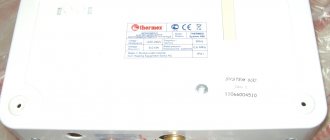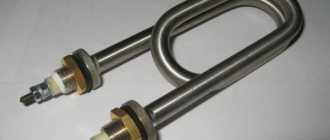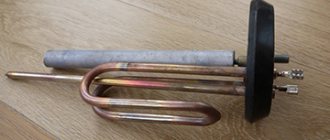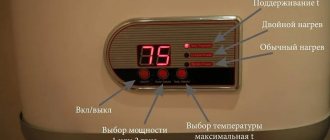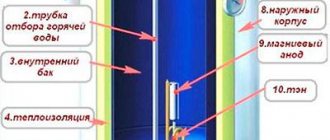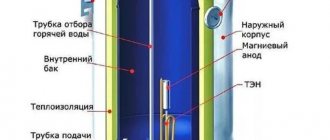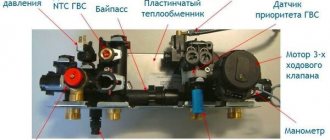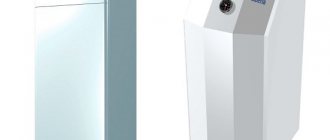Design and principle of operation of the Ariston water heater
The modern Ariston boiler for 30, 50, 80 and 100 liters is a sealed structure consisting of the following parts and assemblies:
- Storage tank:
- Electric heating element (TEH);
- Magnesium or zinc sacrificial electrode;
- Setting and control unit;
- Casing.
The inner surface of the tank must undergo anti-corrosion treatment. Depending on the cost of the product, various modifications may have the following as anti-corrosion protection:
- Titanium coating;
- Glass porcelain coating;
- A layer of heat-resistant enamel that is resistant to aggressive compounds.
In addition, expensive premium water heater models may have all-metal welded storage tanks made of alloy stainless steel.
The air gap between the casing and the inner container is filled with a polymer heat-insulating composition (most often, polyurethane foam). Thermal insulation allows you to significantly slow down the cooling process, thereby reducing energy consumption.
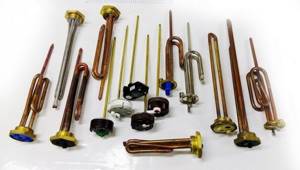
Heating elements are divided into two main types: “wet” and “dry”. Heating elements that come into direct contact with the heated liquid are called wet. In the process of interaction with the working environment, a persistent coating of insoluble scale forms on the outer surface of the heating element, preventing normal heat transfer. To protect against corrosive destruction of the heating elements and the inner surface of the tank, a zinc or magnesium anode is used.
The functionality, information content and ergonomics of a water heater largely depend on the design and design of the control unit and settings. There are two types of control mechanisms: electronic and mechanical. Digital systems have an attractive appearance and are distinguished by precise settings, but are extremely sensitive to voltage fluctuations.

The mechanical unit looks “simpler”, and the adjustment accuracy is not the same, but the reliability of such devices fully compensates for these shortcomings. In addition, the price of models with electronic adjustment is noticeably higher.
The casing of the unit can be made of both metal and polymer materials. The most common is the cylindrical shape, but models of other configurations are in demand.
Models and displacement
Due to the popularity of the product, the manufacturer produces a large number of models with different characteristics. Models with electric heating elements differ in volume and the presence of a storage tank, power, and water temperature limit. The higher the power of the heating element, the higher the maximum heating temperature.
There are also differences in dimensions, weight and installation methods (vertical, horizontal).
The list below shows the most popular Ariston brand water heater models on the market and its brief characteristics:
- ABS VLS (VELIS) EVO PW 50 – electric storage water heater. Volume - 50 l, equipped with a fast heating function, an electronic thermometer for monitoring the water temperature, and a safety device to prevent it from being turned on if the storage tank is empty.
- NTS 80V 1.5K SU 3700366 – electric storage water heater. Volume - 80 l. Equipped with an external temperature regulator in the form of a round scale.
- ABS VLS EVO INOX PW 80 D - electric storage water heater. Volume - 80 l. The tank consists of 2 40-liter compartments. Has the ability to accelerate heating, there are 2 heating elements.
- ABS PRO R 100 V - electric storage water heater. Volume - 100 l. The model is equipped with overheating protection (ABS safety system). Energy savings are ensured by polyurethane foam thermal insulation. Vertical installation is provided.
- ABS ANDRIS LUX 30 - electric storage water heater. Volume - 30 l. The model has a bottom connection for water pipes. The tank is made of steel, the internal coating is Ag+.
There are also small models with 15 and 10 liter tanks. All mentioned products in Tyumen can be purchased in the online store of the KVANTA+ company.
Typical boiler diagram Ariston 50
Ariston electric storage water heater consists of:
- outer body;
- bracket;
- internal tank;
- hot water outlet;
- magnesium anode;
- cold water inlet;
- heat insulator;
- thermostat sleeves;
- heating element (heater);
- flange;
- thermostat;
- power cable;
- regulator knobs.
File description:
Device type: wall-mounted storage electric water heater
Manufacturer: ARISTON
Model: ARISTON ABS VLS PW 30
Instructions in Russian
File format: pdf, size: 10.19 MB
To familiarize yourself with the instructions, you must click on the “DOWNLOAD” link to download the pdf file. If there is a “VIEW” button, then you can simply view the document online.
For convenience, you can save this page with the instruction manual file to your “favorites” list directly on the site (available for registered users).
See instructions for similar models:
You can visit the site using the ARISTON ABS VLS PW 30 model. If you are its user, please leave a detailed review if possible:
Review of the most popular models
The most popular boiler models have different characteristics. When purchasing, the client should pay attention to what functions he expects to receive from the device.
The VLS INOX model is equipped with stainless steel tanks, is easy to install and is manufactured in a flat shape. It is produced in the following displacements: thirty, fifty, eighty and one hundred liters. The cord has a protection system and does not start when the tank is empty. Doesn't freeze or overheat. Copper heaters, power two and a half kilowatts.
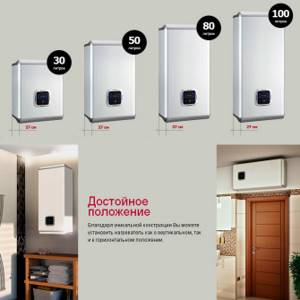
Electric water heater Ariston ABS VLS INOX PW 100
The ABS VLS INOX QH model is similar to the previous one, but has an improved design, fast heating, and a water purification system. The displacement is the same.
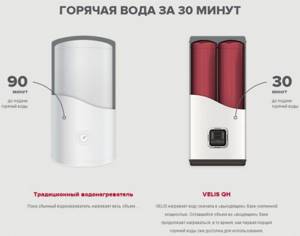
The VLS QH is flat, with a displacement, like the above models. But it heats water in two minutes and is very easy to use. This model is equipped with an LCD display and an automatic saving function. Inside there is steel and three tenons.
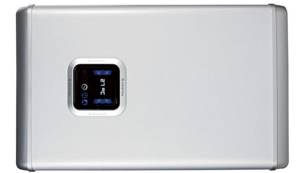
The ABS VLS PW water heater has shutdown protection and protection against bacteria. The tank with a capacity of thirty, fifty and eighty liters is welded using a special new method. The liquid is heated in two containers using a pair of heaters.
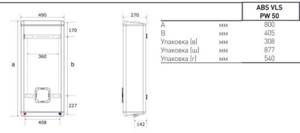
Ariston ABS VLS PW 50
The PRO ECO INOX PVW SLIM model is available with a tank volume of thirty, fifty, sixty-five and eighty, made of stainless steel. Equipped with water pressure. The diameter of the tank is only three hundred fifty-three millimeters. Has a coating that protects against bacteria. Power – one and a half kilowatts.
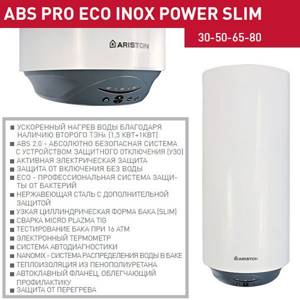
Storage water heater Ariston ABS PRO ECO INOX PW 80V SLIM
The ABC PRO ECO INOX PV boiler is equipped with a tank of fifty, eighty and one hundred liters of narrow cylindrical shape. The model is easy to use, made of stainless steel and comes with a seven-year warranty.
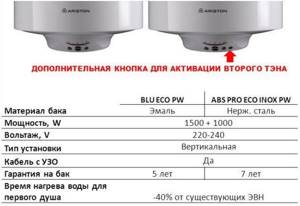
Whatever boiler from this company the buyer chooses, it will still serve him for a long time and without breakdowns. It's a matter of price and what is expected from such a device.
Operating principle of the heating element
The heating element of the boiler is a curved tube, through the center of which runs a conductive thread with high electrical resistance. When current passes, it releases a large amount of heat, which is transferred to the contents of the tank.
To avoid short-circuiting the thread in water, it is enclosed in a heat-conducting insulating layer - quartz sand or magnesium oxide. From the outside, the system is immersed in a copper or stainless steel tube.
When the thermostat receives a signal that the water temperature is too low, it closes the circuit, turning on the heating element. The tube operates until the liquid at the level of the thermal sensor sleeve is heated to the desired level.
If water comes into contact with the outer metal shell, then such an element is called open or “wet”. The heating element, in which the tube is enclosed in a sealed ceramic flask, is closed or “dry”. The first has an advantage in heating speed, and the second in service life.

Diagram of a heating element in a water heater.
Instantaneous water heater
Flow-type boilers are equipped with a small tank in which the heating element is placed in a small tube. When liquid flows through this tube, it heats up. Flow heaters are available:
- Direct heating, which works using a heater, burner or spiral.
- Indirect heating, they work using a heat carrier that heats a pipe with water.
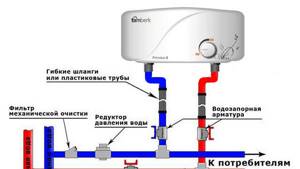
Flow-through boilers are also divided into closed and open. They work on the same principle as accumulative ones. They are divided according to the type of arson:
- To piezoelectric.
- Electronic.
- Hydro turbine.
As soon as the liquid enters the heating tube, a signal is sent to the flow sensors and the heater is turned on. Such boilers are not equipped with cold and hot water mixers. Boilers are also divided by type of heating, namely:
- Gas.
- Electrical.
In the first, the temperature is regulated depending on the amount of gas supplied, and in the second, water heating is controlled by sensors.
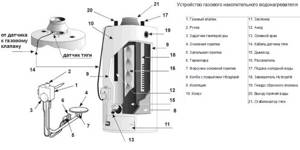
Construction of a gas storage water heater
How to choose the volume of a water heater
The capacity of the boiler is one of the main criteria that must be taken into account when purchasing. Customer reviews and statistical analysis made it possible to determine the required amount of hot water depending on the number of consumers.

For one person, a 30 liter Ariston heater is enough. If two people live in one apartment at the same time, a 50-liter Ariston will fully meet the need for hot water. A family of three or four people will need an 80-liter Ariston. If we are talking about providing a private cottage or a small restaurant, the best option would be “Ariston” with a capacity of 100 liters or more.
Cleaning and Maintenance
Following the manufacturer's recommendations can save the boiler owner from many problems. For example, the instructions usually recommend regular maintenance of the boiler, which boils down to an external inspection and cleaning procedure.
Typically, recommended maintenance periods vary depending on the type of heating element and the nature of its operation. For “wet” heating elements, it is recommended to clean them annually, and for “dry” heating elements - at least once every two years.
If the device is used under increased loads, for example, in production or in a public place, then maintenance should be carried out every six months, regardless of the type of heating element.

During operation, scale and debris accumulate inside the boiler; to remove these contaminants, the device should be cleaned regularly
The maintenance procedure may affect warranty service. Sometimes the manufacturer indicates in the documents that the procedure should be carried out not by the owner of the device, but by repairmen certified by the manufacturer. In this case, it is better to follow the manufacturer's instructions.
Carrying out maintenance yourself is not too difficult. To do this, you need to disconnect the boiler from the power supply and water supply, and then drain the water inside. After this, the housing is opened by unscrewing the fastening bolts and the heating element is removed. The heater and the inner surface of the tank are cleaned of scale and dirt.
The protective gasket and magnesium anode are replaced. Then the device is reassembled and connected to the electrical and water supply networks. One of the common causes of damage to the boiler tank is so-called electrical corrosion. It gradually destroys the surface of the drive, which leads to leakage.
To prevent this problem, many manufacturers install a magnesium anode next to the heating element. This element does not last forever; the task of the device owner is to promptly replace it with a new element. Unfortunately, some people forget about this, which can result in their boiler being completely damaged.
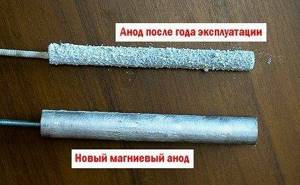
The magnesium anode gradually wears out, it is recommended to replace it with a new element every year or two, depending on the heating element model
Do not forget about such an important protective element as grounding. Its absence not only creates a risk of injury when operating the device, but can also intensify or provoke electrocorrosion
Call a professional or install it yourself?
Many people believe that it is better to entrust all work in which a person has little knowledge to a specialist. After all, it guarantees that your boiler will work for a very long time and will not fail due to the fact that it was installed incorrectly.
But there are also people who do everything in their home themselves, because they do it conscientiously, and not like a master. Just imagine, you were given the opportunity to assemble a computer for yourself completely free of charge, and naturally you will assemble it from the best parts. Now imagine that you do this every day, and collect it for people unknown to you, will you do everything as carefully as the first time for yourself? It’s unlikely, because you’ll just know that it will work and the person will be happy. So here, you can entrust the installation of the boiler to a stranger who will make it work, or you can do it yourself and be sure that if there is any breakdown, you can also fix it yourself, and not contact the experts every month, who can easily help you. you can become one in a matter of hours.
The boiler documentation contains instructions for installing it, so if you follow them, you can do everything yourself, and then be in a good mood that you have achieved it yourself. We figured it out ourselves, solved the problem ourselves, saved money, and most importantly, gained knowledge in this rather demanding area.
And so let’s count the advantages of installing the boiler yourself:
- You will learn something new and in the future you will be able to apply it, as in subsequent malfunctions, and even to the point of installing a boiler for your friends.
- You will save money, and not only the money you would have spent on installation, but also on subsequent visits to the specialist. Believe me, over the entire period there will be quite a large sum for which you can buy 5 more of the same boilers.
But be careful, not all boilers can be installed by yourself; some require a visit from a professional, for example, gas water heaters. Since this is no longer a completely simple matter. But almost everyone can figure out how to handle an electric water heater.
Features of Ariston water heaters
First of all, you need to pay attention to the new product that Ariston introduced into its water heaters. It's called the Fast system. With its help, the device works even faster (double heater and tank). Now you don’t need to wait until all the water has warmed up - as soon as half the tank has warmed up, you can start swimming. And while the first part is consumed, the second will warm up well.
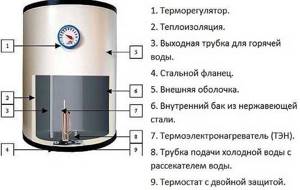
Internal structure of the boiler
The tank is made of steel and covered with different types of coatings. Popular are antibacterial and enameled. The flasks are made of stainless steel. The downside is that it tends to burst along the weld. And the enamel coating does not withstand high temperatures. The maximum recommended temperature for such devices is sixty degrees. If this condition is met, the boiler will last much longer.
But the Ariston company made a knight’s move here too - they began producing tanks with internal coating of titanium, which extends the service life and has electrochemical protection. Without exception, all water heaters with a storage tank have an Eco system, water disinfection and Nanomix - responsible for even heating.
There is an EBC 2.0 system and voltage protection, it is disconnected from the equipment during any power surges.
Thermoelectric models
(for models with a capacity from 50 to 300 liters inclusive)
An additional operation for this type of water heaters is to connect them to the central heating network.
Connect the top terminal of the water heater to the rising circuit of the central heating system, and the lower terminal to the descending circuit, using 2 valves.
We recommend using the bottom valve to disconnect the device from the central heating system when the heating system is not working (valves for connecting to the central heating network are not included in the delivery package.)
Inclusion
If you turn on the boiler for the first time, you should do the following:
- We inspect the inlet pipes to the water heater and find a check valve. If the normal pressure is exceeded, water will flow out of it. Therefore, you should either place a small container under it, or connect and drain the tube into the sewer.
- We fill the tank. Open the valves at the water inlet and outlet of the device. To do this, turn the tap handle 90 degrees counterclockwise. Open the hot water tap. We wait until the container is filled. If water starts flowing, this means that the Ariston boiler is full.
It is advisable to visually inspect the pipes for leaks. If water is dripping somewhere, you need to turn off the water and call specialists to fix the problem.
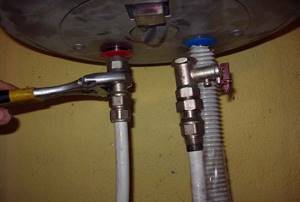
We turn on the device to the network. To do this, we either insert the plug into the socket, or turn on the machine to which the electrical cable is connected. The machine may be located near the installation site or in the distribution panel. We set the desired water temperature. It is recommended to set the level to 60-65 degrees. At higher temperatures, scale actively accumulates, and at lower temperatures, harmful bacteria can begin to multiply.
The temperature can be set with a mechanical knob, as in the Ariston SG 30 OR model, or by buttons on the control panel, as in the Ariston VELIS EVO PW model.
After this, all you have to do is wait until the liquid warms up and start using hot water. For convenience, you can mix cold water from the tap with warm water from the boiler to achieve the desired temperature.
How to turn it on
The design of all boilers (storage water heaters) is the same, so it depends little on the model and brand. Considering that, according to statistics, the most popular manufacturers among Russian consumers are Thermex and Ariston, using their example, we will tell you separately how to turn on the Thermex boiler and how to turn on the Ariston water heater.
The initial installation of equipment is mainly done by specialists, but switching on must be done by the users themselves.
So, how to turn on a Thermex water heater so as not to damage it and prevent mistakes. Connecting an instantaneous water heater is not fundamentally different - the air is also vented, the hot water pipe is shut off, the settings are set and it starts up. The only difference is that the storage one takes 2.5-3 hours to heat the water, and the flow-through one dispenses it after 5-15 seconds.
- The shut-off valve on the hot water pipe is closed.
Even if a tap is installed on the pipe, shut-off valves are still used. The taps can let water through, and then the water from the boiler will go into the common riser.
- Air is released from the system by opening the hot water tap and the outlet of hot water from the boiler itself; lastly, open the cold water tap. The presence of air can be determined by a ragged stream - it will flow intermittently and a “snorting” sound will be heard.
- After the water flow has leveled off, close all the taps, including those on the device itself. Next, connect it to the network.
A separate grounded socket is always used for connection.
- Before turning on the boiler, set the temperature and check the operation.
To make sure it works, do the following:
- check the indicators;
- check the temperature;
- If the device is working properly, the temperature will rise after 15-20 minutes.
If the water heater does not turn on
The first thing you do is check the network elements - electricity, sockets, RCDs, automatic devices. Use a tester to check the voltage in the boiler to rule out a broken cable.
The most common problem is electronics. If power is supplied, but the Thermex water heater does not turn on, look at the error code on the display and check the instructions to see what it means.
- breakdown of the heating element, contamination of the heating element with lime and calcium deposits;
- thermostat failure - when the water temperature rises above 90-92 degrees, the RCD may be triggered;
- there is no water in the tank - if there is water in the system, but it does not flow into the boiler, the reason may be that the air has not been bled.
Even if there was water in the tank before turning it on, but it has not been used for a long time, you should first drain the water, and then be sure to drain the air.
Let us repeat that there is no fundamental difference in connecting storage devices, so we will schematically describe how to turn on an Ariston boiler.
- If we are talking about an apartment or house with a centralized supply of hot water, close the pipe with shut-off valves.
- Open the tap in the place where the unit is installed and drain the water, close it.
- You bleed the air from the boiler, for which you first open the inlet tap (the pipe is marked in blue), then the heated water tap (marked in red). Wait until all the air comes out and the water flows in an even stream without interruption.
- Do not close the cold water supply tap - its quantity in the boiler is regulated automatically.
- Plug it in and set the temperature on the device.
- Check the functionality - after a few minutes the temperature in the tank should begin to increase.
What errors can you encounter during operation?
Instantaneous water heaters
As for compact water heating devices, we note that their installation is very simple:
- remove the old tap;
- install the unit;
- connect to a pipe with cold water;
- turn off the hot one;
- plug into the outlet.
At this point, the installation is complete and then you just need to turn on the hot water tap and use it. With this equipment, there should be no questions about how to turn on the boiler when it is already installed. If you don’t risk installing it yourself, contact a specialist.
All listed devices belong to high power equipment (from 3 to 7 kW), they are prohibited from being connected to a common outlet. A separate outlet should only be located in a dry place, and power should be supplied directly from the distribution panel.
Useful tips
Be sure to take into account the advice of professionals:
- Determine in advance the number of places to which water will be distributed from the boiler.
- Before starting work, purchase all the missing materials so that during the process you do not have to urgently run to the store for individual parts.
- Be sure to follow the instructions for your model.
- All water connections must be carefully sealed.
- If it is not possible to install a protective drain into the sewer, place a protective pan under the device.
- If you do not provide tap water, the storage heater can be supplied from a separate container. It is mounted at a height of about 5 meters from the top of the device.
- Do not forget about preventive procedures - be sure to change the magnesium anode at least once a year.
- If you are leaving for a long time, drain the water from the heater after unplugging it.
- Until the tank is completely filled with water, you cannot turn it on and set the heating mode.
- Do not operate the device while electricity is connected to it.
- Use only those parts that are compatible with your model and recommended by the manufacturer.
Let's consider the main advantages and disadvantages of storage water heaters.
The heating element is faulty
The device is connected to the network, but the heating element operating indicator light does not light up, and the liquid does not heat up. You can determine the breakdown in the following ways.
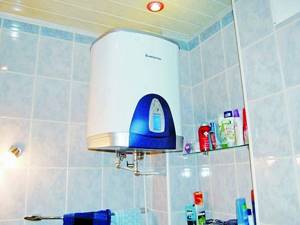
You need to take a tester, set it to 220-250 V, measure the voltage at the terminals connecting the cable to the thermostat, if there is a signal, measure the potentials at the terminals of the heating element. If the indicators there are normal, it means that the heating element itself is broken.
We turn off the storage water heater from the network, set the measuring device to the Ohm resistance measurement scale,
then we disconnect the heating element from the thermostat and release the wires from the terminal so that the contacts of the heating device are exposed. We measure the resistance value (Ohm) in the contacts of the heating device; if it is working properly, a certain value will appear on the screen, the number is not so important in this case.
If it does not show any value, you need to purchase a new one, since this one is faulty and not suitable for repair, it is recommended to simultaneously replace the flange seal and anode.
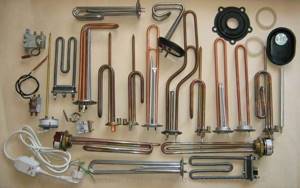
Now let’s describe in more detail how to remove the heating device from the boiler with your own hands:
- Turn off the power to the boiler and shut off the water supply from the main.
- Unscrew the bolts from the protective panel and remove it.
- Disconnect all wires.
- Unscrew the bolts that secure the heating element, there are usually 6 of them.
- Use a rotating motion to remove the heating element.
- Clean the tank and replace the necessary parts.
- Reassemble everything in the reverse order; it is recommended to tighten the bolts evenly.
Tools and materials
To replace the heating element, you will need the following tools:
- hub wrench 55 or adjustable wrench No. 2 (with the appropriate size of the fixing nut);
- socket and ratchet wrenches (for mounting on a bar or flange);
- crosshead screwdriver;
- multimeter, indicator probe.
To clean the surface of the heating element, you will need citric acid or a vinegar solution. When replacing a heating element or anode, you need to prepare a new part with similar dimensions and technical characteristics.
How to choose the right one
A wide range of models sometimes makes it difficult to choose the right device, but it allows you to find the best model. When choosing, you need to pay attention to several characteristics:
- Internal coating of the tank. It can be made of stainless steel or enamel with silver ions.
- Power. The rate of water heating depends on it. In some models, it is possible to select power - an economical mode, in which the water is heated only to 550. Another mode is antibacterial, providing strong heating, during which the tank is disinfected.
- Features of heating elements. They can be coated with a special anti-corrosion compound that prevents scale formation.
- The presence of a thermostat ensures accurate heating to the selected temperature.
Storage boilers
There are many different models, but a few are popular.
Water heating equipment of the ABS series are divided into several more types, namely Slim Fit - famous for its compactness; Platinum Slim – made from stainless steel; Silver Platinum Slim – with silver plating that prevents rust; The Shuttle model is flat and rectangular.
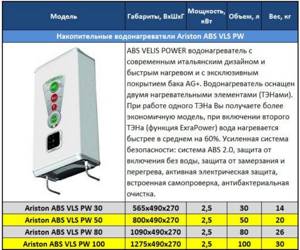
Storage water heaters Ariston ABS
Boilers of the TI Shape series are coated with titanium coating and equipped with a liquid crystal screen that makes it easier to control the heater; TI Shape Control operates using a remote control.

Characteristics of TI Shape brand boilers
Super Glass Small water heaters are a small, compact size device that can be installed anywhere. Coated with fine enamel.
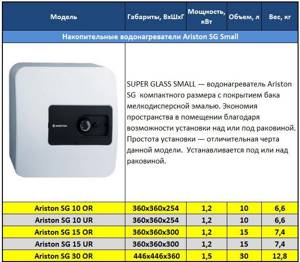
Ariston SG water heaters
Eureka boilers are made in an interesting shape - a balloon. It is produced in two versions - with a tap or with a shower. The tank is made of heat-resistant plastic.
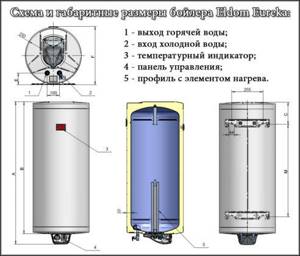
Diagram and overall dimensions of the Eldom Eureka boiler
Industrial models are designed for heating large volumes of water. They are produced in two types: one can be mounted on the wall, the other can be placed on the floor. The coating of such boilers is titanium.
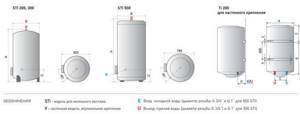
Ariston Ti Tronic Industrial STI
Velis water heaters are equipped with remote control and have double power. The shape of the boilers is flat, with interchangeable color displays.
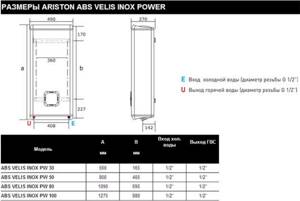
Ariston ABS Velis
Water supply
Next comes the connection to the water supply. A diagram is thought out, first drawn on a sheet of paper, and then transferred to the walls with real dimensions. Holes are drilled along the lines where the pipes will pass and clips are installed.
We close the valve at the water inlet and install a tee on the branch closest to the boiler. A pipe runs from it to the water heater. A valve is installed on it to make it convenient to repair the device, a strainer and a check valve.
We lead a flexible hose to the boiler and connect it to the pipe. Typically the input is indicated in blue. We draw a branch to the watershed point in the same way. It is not recommended to connect without flexible hoses. On the one hand, it looks better and more reliable, but if there are sudden changes in pressure, the tank takes the brunt.
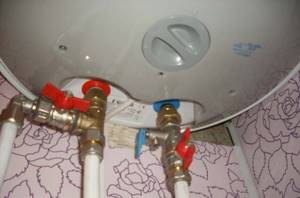
The inlet to the boiler is marked in blue
After connecting all components, the valves are opened and all connections are checked for leaks. If they are detected, reconnections are made or more tow is added to the threads.
Ariston water heater repair
Scale on the heating element.
Ariston water heaters are reliable household appliances, but they are also susceptible to some malfunctions. The most common are the appearance of scale on the heating element, failures in the electronic control unit and low pressure when supplying water to the tank.
For repairs, it is preferable to use the services of professionals. Guidance and advice on these issues can be obtained from KVANTA+.
How to identify a malfunction
To carry out repair work, the user must notice a malfunction in the operation of the water heater in time. Ariston boilers are often equipped with an electronic display on which messages appear in the event of equipment failures.
Direct signs of a malfunction may be:
- the machine is triggered when the boiler is turned on - this indicates a malfunction of the heating element;
- heating water above the maximum permissible temperature - this indicates a failure of the thermostat;
- heating of water below the required values - this may indicate contamination of the heating element, the appearance of scale;
- drips in the lower part of the tank and on its walls;
- breakdown of the information display, which most often does not cause significant disruptions in the overall functionality of the device, but can reduce comfort during its use.
An indirect sign can be considered extraneous noise during operation of the electric heater.
Basic faults
Ariston water heater repair specialists consider several key components to be the most vulnerable:
- heating element;
- magnesium anode;
- thermostat;
- safety valve;
- control board;
- thermostat;
- O-rings, adapters, switches, gaskets.
Regular inspections of heating elements help to promptly identify violations of the integrity of the shell. Read more about the design of different models of Ariston boilers.
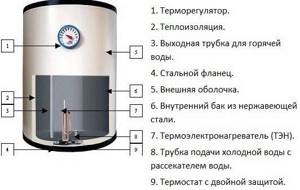
The most common defects of Ariston boilers:
- failure of the heating element;
- thermostat failure;
- reduction in water heating due to scale formation;
- leaks caused by aging gaskets;
- the appearance of corrosion in the storage tank.
Simple repair of Ariston brand water heaters
Regardless of the frequency of operation, each boiler needs periodic cleaning of lime deposits. Ariston technology specialists recommend making simple repairs after 1-1.5 years. The low quality of liquid in the main network forces water heaters to be serviced much more frequently.
The reason for urgent descaling may be negative changes in work:
- the appearance of hissing and other atypical sounds during heating;
- frequent turning on and off of the device;
- increasing heating time.
Instructions:
1. De-energize the house and turn off the equipment by disconnecting the wires from the thermostat.
2. Disconnect the hot water pipe. Instead, choose a drain hose with a smaller diameter, which you lower into the sink or bathtub.
3. Remove the heating element (nut fastening on a metal plate) and pull out the thermostat. To make dismantling easier, it is recommended to press the flange towards the inside of the heater.
4. In the opened hole, lime deposits will be clearly visible on the walls. They are removed by hand and a rag moistened with a solution that neutralizes scale.
5. The dismantled elements are installed in their places. The tank is filled with water and electrical wires are connected.
6. Connection is best done using plastic pipes. They are much more practical and reliable than hoses made of rubber or metal-plastic.
7. In order not to confuse the contacts (phase and zero), technicians advise using an indicator screwdriver. The diagram drawn on the thermostat also helps to avoid errors when connecting.
8. Installing an RCD (residual current device) system in Ariston will protect you from electric shock. Its task is to immediately disconnect from the network at the first sign of a short circuit.
9. Inspect the Ariston boiler for leaks. To do this, fill the tank and leave it unplugged for 1-2 hours. If no leaks are detected during this time, then the water heater can be started.
Ariston storage water heater repair specialists categorically do not recommend cleaning with abrasive materials. This negatively affects the internal surfaces of the unit. The scale dissolving agent can be completely replaced with a solution of citric acid. It is enough to pour it into the Ariston boiler tank and leave it for a day. The heating element can be repaired in the same way. To do this, the heater is immersed in a composition with citric acid overnight. During this time, the main scale dissolves, and the remains can be easily cleaned off with a rag.
Ariston instantaneous electric boilers
The Bravo E water heater is equipped with an electronic manual, sensors for operation and changes in water temperature.
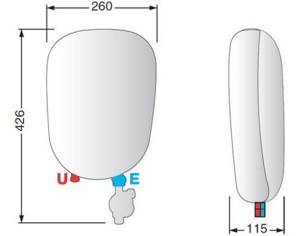
Water heater ARISTON BRAVO E 4523 UF – its dimensions
The Bravo M boiler has a mechanical manual. The boiler kit includes a filter and a shower head.
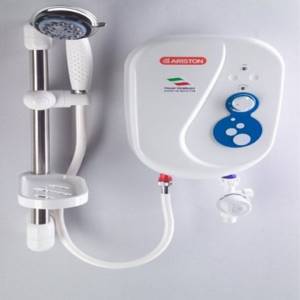
Boiler depressurization
Another equally common problem is leakage. There are two possible sources of such a breakdown: a breakdown in the tank or a leaking flange.
If the tank leaks, it makes no sense to carry out repairs, since replacing it will be very expensive. It’s another matter if the Ariston water heater is still under warranty, then you have the opportunity to return the device.
And if the cause of the leak is the flange, there will be no difficulties in eliminating the breakdown. You need to drain the water, remove the gasket, go to the store with it and buy a similar one. Then replace it and that's it.
The lineup
Flat boiler Ariston
The range of water heaters is quite huge and is constantly being updated. They are very compact, although they have a large displacement. For a family of four, an 80-liter capacity is ideal.
Square tanks with mechanical controls are very common. The only drawback is the unimproved fastening mechanism.
There are also models with a maximum capacity of 100 liters. Such units are capable of providing industrial shower rooms. The insulating layer of such models is made of polyurethane foam.
The Ariston range of water heaters can have both an advanced electronics system and a simple control mechanism. The warranty on bulk tanks is given on average for seven years. For additional fastening of boilers, special metal frames are made.
Water heater devices
Why exactly 80 liters? Very simply, according to statistics, this volume is considered the most popular among the population. This amount of water is enough for an average family of three.
How does this device work? Today, the boiler is required not only to heat water, but also to maintain the set temperature for as long as possible.
As a rule, an 80-liter unit is flat in shape, but can be round. Inside there is a stainless steel tank. In the middle there is a heating element (heating element). Next to it is a magnesium anode that protects the device from scale.
Also inside there is a short tube for supplying cold water and a long one (almost to the top) for releasing hot water. This is to ensure that hot water does not flow until the tank is full. Thanks to this, the heating element will always be in the water.
On the front side of the boiler there is a thermostat, and on the bottom there is a thermostat and water outlets. The space between the outer shell and the inner tank is filled with heat-insulating material. When purchased in a store, a valve and fastenings are included with the water heater.

On the front side of the boiler there is a thermostat, and on the bottom there is a thermostat and water outlets
User manual
Despite the ease of operation, you should read the technical manual before use. It is advisable that the installation and connection be carried out by a specialist who will provide all the details, install an RCD and check the grounding. Before turning on for the first time, you need to fill the tank and then open the hot water tap. This will help get rid of air in the pipes. Only after this the device can be connected to the network.
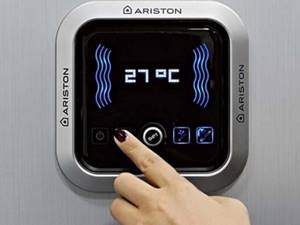
The instructions do not recommend installing the water heater in a room with poor ventilation or poor-quality wiring. Do not leave water in the tank or turn on the device if the air temperature drops below 0.
The water heater is easy to use.
- Fill the tank.
- Connect to the network.
- Press the power button.
- Select the required power.
- Set the temperature.
- After heating, turn off the device from the network and you can use hot water.
Do-it-yourself water heater cleaning
Any Ariston boiler needs periodic descaling. Experts recommend doing this regularly (once or once a year and a half). The final verdict on cleaning the heating element from scale depends on the frequency of use of the device, as well as the quality of the liquid. It is not difficult to determine that the moment has arrived
Just pay attention to the obvious changes:
- an uncharacteristic hissing appeared when heated;
- heating time has increased;
- The boiler began to turn on and off more often.
Despite the high quality of parts of Ariston boilers, standard maintenance of any model will not be difficult even for beginners. If you have free time, obedient hands and enough patience, then you don’t have to spend your personal budget on specialists; you can repair the water heater yourself. Review the following simple maintenance procedures:
1. De-energize the room and turn off the water heating device by disconnecting the wires from the thermostat.
2. Proceed to draining: select a hose whose diameter is several millimeters smaller than the water discharge outlet (where the safety valve is). Disconnect the hot water pipe from the boiler without closing the tap - this action opens the valve.
3. Place the free end of the hose into the sink, bathtub or toilet.
- close the cold water supply channel;
- disconnect the hose from it;
- then connect to the ball valve;
- go back to point 3.
4. While continuing to repair and clean the Ariston boiler yourself, remove the heating element (it is usually secured with a nut on a metal plate). After removing the water heater from its mountings, carefully pull out the thermostat. To make it easier to remove the heating element, push the flange inside the heater, then try to pull it out.
5. In the hole you will see scale that has formed, which will need to be removed, which can be done simply with your hands or a technical rag with a product that neutralizes limestone deposits. But under no circumstances use abrasive materials, this will have a detrimental effect on the surface of the device. If there is no special product in the house, use a proven folk method: dilute citric acid in water, pour it into the Ariston water heater tank and let it sit for a day.
After the procedure, rinse the water heater tank with a stream of clean water to remove any remaining scale. The heating element is cleaned in the same way: immerse it in a solution of citric acid for 1 day. In case of critical contamination, it is better to purchase a new one, similar to the standard one.
You should pay attention to the magnesium anode, which is located next to the heating element. Replacement is usually carried out once or twice a year
Use original anodes from the manufacturer for each individual Ariston water heater model.
6. Next, in the maintenance order, you only need to put all the dismantled parts in their places, pour water into the Ariston boiler, connect electricity and water supply to it.
7. It is better to connect the Ariston boiler to the supply system using plastic connecting pipes - they are more reliable and durable than conventional flexible or metal-plastic hoses.
8. Do not confuse phase and zero! Use an indicator screwdriver to identify these pins. If you have forgotten how the boiler was originally connected, refer to the diagram shown on the thermostat.
9. To protect yourself from electric shock during repairs, install an RCD (residual current device) system. It is designed to instantly turn off the water heater at the first sign of a short circuit.
10. Before the final start-up of the Ariston boiler, carefully check it for leaks by filling it with water. Let it sit for a couple of hours after repair without operation, and if the liquid does not leak outside the tank, the boiler can be turned on.
Why are Ariston water heaters created?

Household water heating appliances that run on electricity are most often used during hot water outages. As a rule, compact models are purchased. When professionally installed, the water heater provides warm water for daily household needs: washing, cleaning or showering.
In private sectors, larger volume gas and electric heaters with storage are used with all communications. In this case, household appliances from the famous Italian company are used all year round.
Blitz tips
A few tips that will allow you to extend the life of the device without overpaying for electricity:
- Do not unplug the device. Maintaining a set temperature takes much less energy than heating it up. This is especially true in winter, when the water temperature is especially low.
- If hot water is needed less often than once a day, then it is better to turn off the device. In this case, heating will take less energy than maintaining the temperature.
- Significant savings are achieved through controllers. The unit can be programmed to heat water at the desired time.
- If possible, use the controller mode marked “E” (Eco).
- Do not allow water to flow aimlessly. Once again, turning off the tap for a couple of minutes will save you a lot of energy and money.



